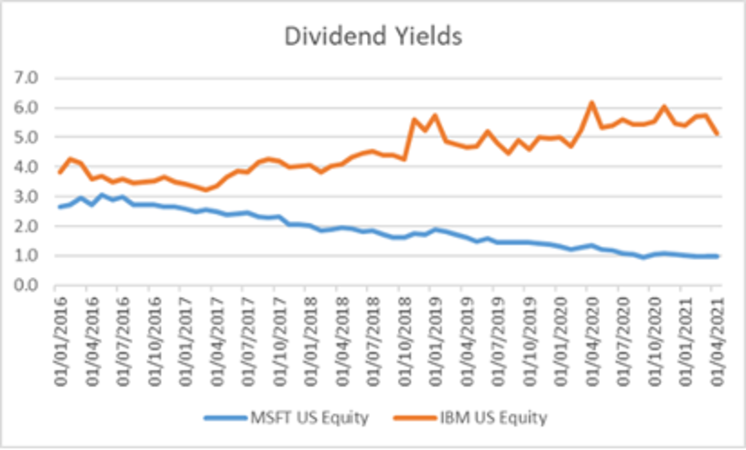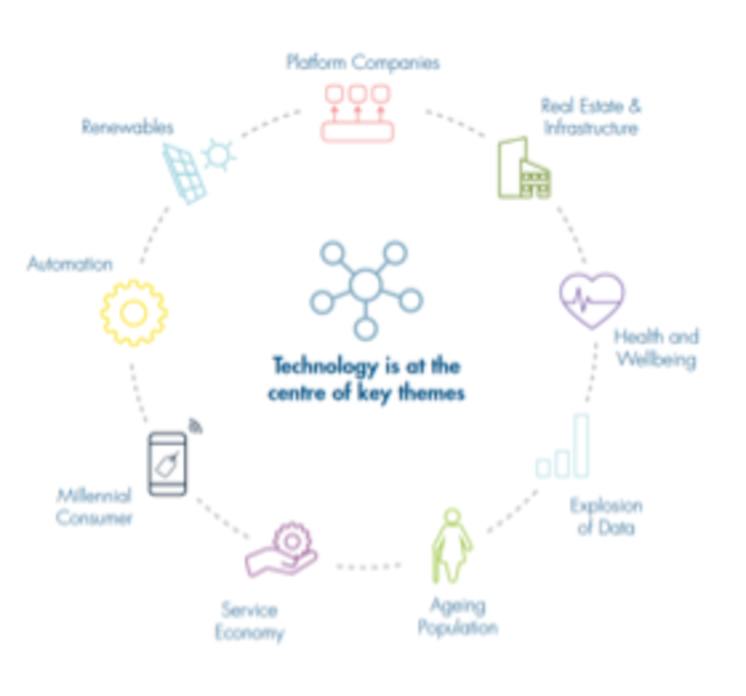Leadership is key to dividend growth and consistency
We invest in leaders within our nine themes – leadership enables them to capitalise on the thematic tailwind that they have. In the Mirabaud – Sustainable High Dividend Fund, we tend to invest in companies which are in a slightly later stage in their lifecycle, where growth is still very attractive but where they have already sunk the expansionary capex and which are therefore highly cash generative. This cash flow can therefore be used to return capital back to shareholders through dividends. Usually, there are investment grade-rated companies, which enjoy high free cash flow yields and have strong moats and strong balance sheets. Other attributes of leadership also include management and technology leadership, and more importantly, we are careful to make sure that a company and its management has the capability to capture these tailwinds.
We are also seeking to build a portfolio where dividend growth is expanding faster than global GDP.
2020: A challenge for income investors
2020 was a tough year for income investors, and the MSCI All Countries World high dividend Index (high dividend index) underperformed the MSCI All Countries World Index (broad market index) by a wide margin of -15%[1]. When we look at the source of returns for the high dividend index, yields remained somewhat flat. However, dividends per share at an index level fall 9% in 2020[2] because some companies suspended dividends given the macro backdrop as a result of the pandemic. Some companies held back paying dividends because of the uncertainty and some were prohibited from paying dividends by governments, such as in Europe.
In normal circumstances, we would expect a high yield index to have a lower beta than the overall market, and therefore outperform in down markets. However, with the threat of unpaid dividends, the market was far from normal, and the high dividend index performed in line with the broader market -33% versus -32% from the start of 2020 to the market lows on 23 March 2020. The high dividend index then lagged significantly during the recovery from the market lows, returning 50% versus 71% from the broader market to the end of 2020[3].
Against this backdrop, the Mirabaud - Sustainable High Dividend Fund was up 7.2% in 2020, ahead of the high dividend index, but below the broader market[4].
Strong value in income names
Given the significant performance comparisons between the two indices described above, this means the high dividend index ended 2020 trading at a significant discount to the broader market index, representing a 10-year low on a relative valuation basis. So far this year, leadership has changed and the high dividend index (up 13%) has outperformed the broader market index (up 12%)[5]. Some of this outperformance has been driven by Energy, Banks and Mining stocks as we go through the first stage of the recovery, and these are areas where we are typically underweight.
In the case of Energy and Mining we have zero weights from an ESG perspective. We have pursued an ESG approach to income investing since the launch of the fund in and our long-term track record shows that ESG complements our return profile. Income investors have historically hidden in high yielding names in areas like Tobacco, and Energy, and we do not believe this is good enough from an ESG perspective.
We do not invest in many banks, preferring structural growth names like Carlyle Group, the private equity firm, which again sits within our Real Estate and Infrastructure theme. The company has been taking share from banks in areas where this latter group have been struggling to operate due to over- regulation and capital constraints. We do have exposure to one bank in the portfolio, Sberbank, the leading Russian bank which generates industry leading Returns on Equity.
A balancing act
When these lower quality areas of the market lead, the Fund tends to lag because the portfolio is mainly weighted towards high quality, lower cyclicality and lower beta names. In market environments like this, we have to manage downside risk and stay true to our quality ethos. We do this by increasing the weighting of names in the Fund, which have a higher degree of cyclicalty, like Cummins, Union Pacific, and Tokyo Electron. All of these names are high quality names with thematic tailwinds, and they are ESG leaders, but they do operate in more cyclical areas.
We believe that in the time in the market where low quality, highly cyclical names lead, is coming to an end. As Purchasing Managers Indices peak and as economic growth decelerates from here on the back of tough year-on-year comparisons, we expect this environment to be consistent with a move from early cycle to mid-cycle. Against this backdrop, valuations on dividend names remain attractive relative to the broader market.
In the Mirabaud – Sustainable High Dividend Fund, we invest a combination of income and growth, and we believe that this sets the Fund up very well for the coming period when the cycle changes. Over the next 12 months, we expect the fund to grow earnings 15% versus the broad market, which is growing 9%[6]. We also believe we have twice as much potential for multiple expansion than the market, given the valuation discrepancy.
We believe valuations are attractive on dividend stocks, and on high quality stocks, and the market is moving away from early cycle names. These are positive attributes for the Fund, which invests in high quality franchises, with high growing dividends. Furthermore, we believe that the themes we invest in ensure the durability of that growth, and we believe that ESG is becoming more and more important in framing the investment case in managing future risks and opportunities.
| 2021 | 2020 | 2019 | 2018 | 2017 | 2016 |
Fund I Cap UDS | 8.85% | 7.18% | 26.63% | -7.63% | 19.29% | 2.53% |
Benchmark | 10.84% | 16.25% | 26.60% | -9.42% | 23.97% | 7.86% |
Benchmark: MSCI All Countries World Index. 2021 figures to 31 May 2021. Past performance is not indicative or a guarantee of future returns.
IMPORTANT INFORMATION
This marketing document contains information or may incorporate by reference data concerning certain collective investment schemes ("funds") which are only available for distribution in the countries where they have been registered. This document is for the exclusive use of the individual to whom it has been given and may not be either copied or transferred to third parties. In addition, this document is not intended for any person who is a citizen or resident of any jurisdiction where the publication, distribution or use of the information contained herein would be subject to any restrictions or limitations.
The contents of this document are provided for information purposes only and shall not be construed as an offer or a recommendation to subscribe for, retain or dispose of fund units, shares, investment products or strategies. Before investing in any fund or pursuing any strategy mentioned in this document, potential investors should consult the latest versions of the relevant legal documents such as, in relation to the funds, the Prospectus and, where applicable, the Key Investor Information Document (KIID) which describe in greater detail the specific risks. Moreover, potential investors are recommended to seek professional financial, legal and tax advice prior to making an investment decision.
The sources of the information contained in this document are deemed reliable. However, the accuracy or completeness of the information cannot be guaranteed, and some figures may only be estimates. There is no guarantee that objectives and targets will be met by the portfolio manager.
All investment involves risks. Past performance is not indicative or a guarantee of future returns. Fund values can fall as well as rise, and investors may lose the amount of their original investment. Returns may decrease or increase as a result of currency fluctuations. This communication may only be circulated to Eligible Counterparties and Professional Investors and should not be circulated to Retail Investors for whom it is not suitable.
This document is issued by the following entities: in the UK: Mirabaud Asset Management Limited which is authorised and regulated by the Financial Conduct Authority under firm reference number 122140.; in Switzerland: Mirabaud Asset Management (Suisse) SA, 29, boulevard Georges-Favon, 1204 Geneva, as Swiss representative. Swiss paying agent: Mirabaud & Cie SA, 29, boulevard Georges-Favon, 1204 Geneva. In France: Mirabaud Asset Management (France) SAS., 13, avenue Hoche, 75008 Paris. In Spain: Mirabaud Asset Management (España) S.G.I.I.C., S.A.U., Calle Fortuny, 6 - 2ª Planta, 28010 Madrid. The Prospectus, the Articles of Association, the Key Investor Information Document (KIID) as well as the annual and semi-annual reports (as the case may be), of the funds may be obtained free of charge from the above-mentioned entities.


